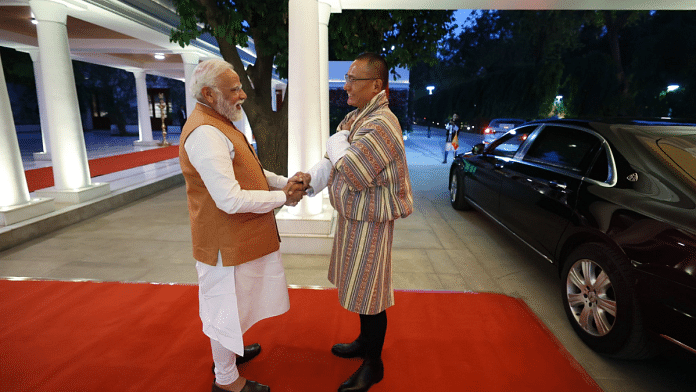New Delhi: Amid its border talks with China that could have strategic impact on India, Prime Minister Narendra Modi will be travelling to Bhutan next week to reiterate New Delhi’s commitment to Thimpu.
“The message is very clear. We stand with you,” a source in the government said when asked why Modi is travelling to Bhutan.
A new government has come into being in Bhutan, the source said, adding that Modi’s visit will reiterate the highest regard that India gives to its neighbour.
“Our economic, diplomacy and military ties with Bhutan is unlike what we share with any other country and the visit will reiterate this,” a second source said.
The sources said Modi would be reaching Bhutan on 21 March and stay back for the night as flights cannot take off from Paro after 12 PM because of clouds and turbulence. Modi’s trip was formalised during the ongoing visit of the new Bhutanese PM Dasho Tshering Tobgay to India, they added.
Both the prime ministers met on Thursday evening and reviewed the progress in various areas of bilateral partnership, including infrastructure development, connectivity, energy, hydropower cooperation, people to people exchanges and development cooperation.
They reaffirmed their commitment to further strengthen the special and unique India-Bhutan friendship.
The visiting prime minister conveyed his deep appreciation for India’s role as a reliable, trusted and valued partner in Bhutan’s developmental priorities, an official statement said.
On behalf of His Majesty the King of Bhutan, Tobgay extended an invitation to Prime Minister Modi to visit Bhutan next week.
Also Read: Does China-Bhutan thaw signal trouble for India? Not quite
What India is concerned with Bhutan-China talks
In January, Army Chief General Manoj Pande had said India and Bhutan have common security concerns and that his force was closely monitoring the border talks between Thimpu and Beijing.
Both China and Bhutan have agreed to fast-track the talks over delimitation and demarcation of the border, besides establishing diplomatic ties. These talks will have an impact on India’s strategic interests because the territory under negotiations is close to India’s borders with Bhutan, and could fall under Chinese control.
As reported first by ThePrint in 2019, China and Bhutan were at that time close to striking a deal on the Doklam dispute. The Chinese holding line in the contentious region was to become the working boundary between the two countries.
While a formal agreement on this aspect has not been inked yet, China is already in control of the area and have built several dual-use villages on Bhutanese territory, near the tri-junction with India.
As ThePrint reported in October, China claims around 764 sq km of land in northwestern and central Bhutan. This dispute goes back to the Chinese occupation of Tibet in the 1950s.
In 1959, China seized control of eight enclaves of Bhutan and refused to recognise the “dividing line” between Tibet and Bhutan. Talks have continued since then on three areas of contention — the Jakarlung and Pasamlung areas in north Bhutan, and the well-known Doklam area in west Bhutan.
Doklam had seen a stand-off between India and China in 2017. Post the stand-off with India, China asserted ownership of the Sakteng Wildlife Sanctuary, which is located in eastern Bhutan and borders Arunachal Pradesh.
This is seen by India as a ruse to pressure Bhutan because China is willing to give up its claim on the sanctuary if Thimpu agrees to hand over Doklam.
A plateau with an area of approximately 89 sq km and a width of less than 10 km, Doklam is of huge strategic interest to India as it overlooks the Siliguri corridor — a gateway to the Northeast region.
Since the late 1990s, China had captured small pieces of land in Doklam and had started building a road. In 2017, it started constructing a road headed to the strategically important Jampheri ridge-line.
On 18 June 2017, Indian soldiers walked into the area to form a human wall to prevent Chinese earth excavators and workers from carrying out construction activities.
(Edited by Tony Rai)
Also Read: China is launching a two-pronged attack on Bhutan and Arunachal—with strategic ‘lawfare’



